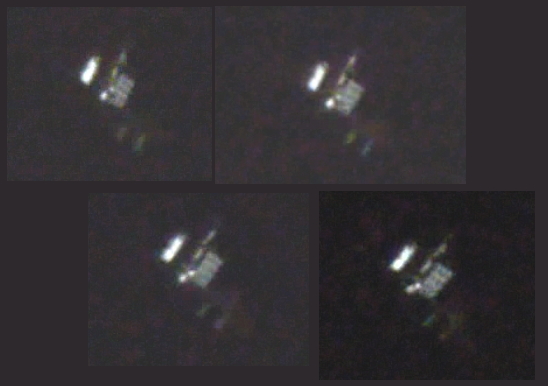
Nikon D7000 DSLR Imaging with Meade 8" LX200-ACF:
ISS, M71 Globular Cluster
Posted: 7 June 2013
The observatory was opened Thursday, 6 June 2013, at 1832 MST, 106°F. The sky was clear. At 1845 MST, viewed Mercury, 222X + #21 Orange filter and 444X + #21 Orange filter. I then mounted the iPhone 4 on the 8" LX200-ACF using the MX-1 afocal adapter. I did several video recordings of Mercury, 444X + #21 Orange filter. However, seeing was not good and none of the videos or individual frames from the videos were clear enough to show the surface detail I have been seeing on the past several evenings. I ended imaging at 1920 MST. I viewed Mercury, 364X + #21 Orange filter. The surface detail was visible. It was also visible without the filter.
At 1925 MST, viewed Saturn, 364X. Saturn was just barely visible in the 7x50 finderscope. I confirmed alignment of the finderscope for the upcoming excellent ISS pass. I then updated the ISS TLE. Sunset occurred at 1930 MST. I mounted the D7000 DSLR at prime focus of the 8" telescope with a 2X Barlow Lens added. I initially focused on Saturn since my target focus star, Spica, was not yet visible. At 1942 MST, did the focus test on the star using a Spike-a Bahtinov Mask. At 1942 MST, I was ready for the ISS pass, which would begin at 2001 MST. The pass would initially start behind a tree to the southwest, but would climb to near the zenith, and continue down to the southeastern horizon.
Tracking was good during the first half of the pass as the ISS climbed higher in the sky towards the zenith. After passing the zenith, tracking was not very good (typical problem for passes to the north of the zenith with my wedge-mounted telescope). The final, low elevation, portion of the pass had good tracking, but the space station was too low and too distant for good imaging. However, at it highest point in the pass, using 1/1600sec, ISO 3200, I was able to acquire these images from individual frames from the HD video recording:

A lot of the structure of the ISS is visible.
At 2015 MST, viewed Saturn again, 83X. Four moons were visible. I then began preparing the D7000 for deep sky imaging. At 2020 MST, I terminated the first Kissing Bug of the night. I then put the telescope to "sleep". As an experiment, I decided to leave the observatory during what seemed to be the prime time for Kissing Bugs, 2000-2200 MST. As I was leaving the observatory, Kissing Bug #2 and #3 were terminated. The observatory was temporarily closed at 2023 MST.
The observatory was re-opened at 2222 MST. Viewed Saturn, 364X. Four moons still visible: Titan, Dione, Tethys, and Rhea. At 83X, I picked up what was probably the moon Iapetus. At 2234 MST, viewed M71 (globular cluster), which would be my DSO imaging target for the night. M71 was currently too low in the sky for imaging, although I did view it at 222X. I also viewed M57 (Ring Nebula) and M56 (globular cluster) at 222X. Viewed Epsilon Lyrae (the "Double-Double" star), 222X. The secondary stars were nicely separated at 222X. Then viewed the nice double star Albireo. The different star colors were very obvious at 222X.
At 2300 MST, slewed the 8" telescope to the star Altair, which would be my focus test star. M71 was still a little too low for imaging so I did a tour of the Milky Way using 7x50 binoculars. At 2310 MST, Kissing Bug #4 was terminated. At 2320 MST, did the focus test using the Bahtinov Mask with the D7000 DSLR mounted at prime focus of the 8" telescope using the off-axis guider. I did several guided images of M71 (globular cluster) at various exposure lengths and ISO settings. This is a full-frame image of M71, 60 seconds, ISO 5000:

I ended imaging at 2343 MST. I then began viewing several DSOs. First was M8 (Lagoon Nebula). With the Meade 2" 24mm Ultra-Wide Angle eyepiece (83X), the view of the nebula was impressive, with lots of structure visible. Other DSOs viewed: M22 (globular cluster), M24 (open cluster), M23 (open cluster), M20 (Trifid Nebula), M21 (open cluster), NGC6530 (open cluster), M18 (open cluster), M17 (Swan Nebula), M28 (globular cluster), M69 (globular cluster), M25 (open cluster), M70 (globular cluster), M54 (globular cluster), M55 (globular cluster), NGC6822 (Barnard's Galaxy, irregular galaxy), and M75 (globular cluster), M16 (Eagle Nebula), M5 (globular cluster), and IC4756 (open cluster). The 2" 24mm UWA eyepiece really provided some great views of these DSOs.
The observatory was closed at 0037 MST, 77°F. My Kissing Bug experiment worked; saw significantly less of them this night than on several previous nights.
Comments are welcome; use the Comments section below, or you can Email Me. Thanks.
Cassiopeia Observatory Home Page